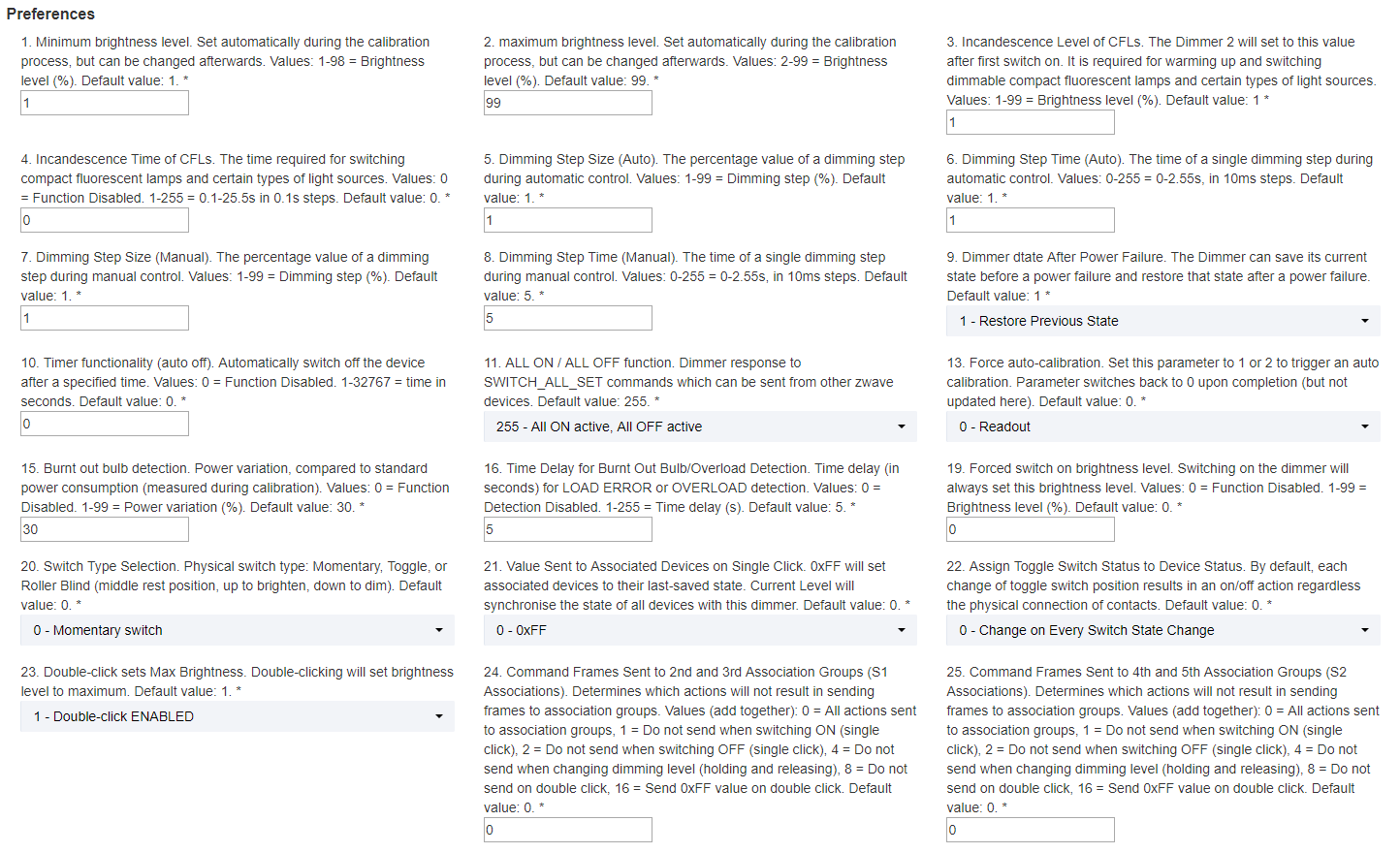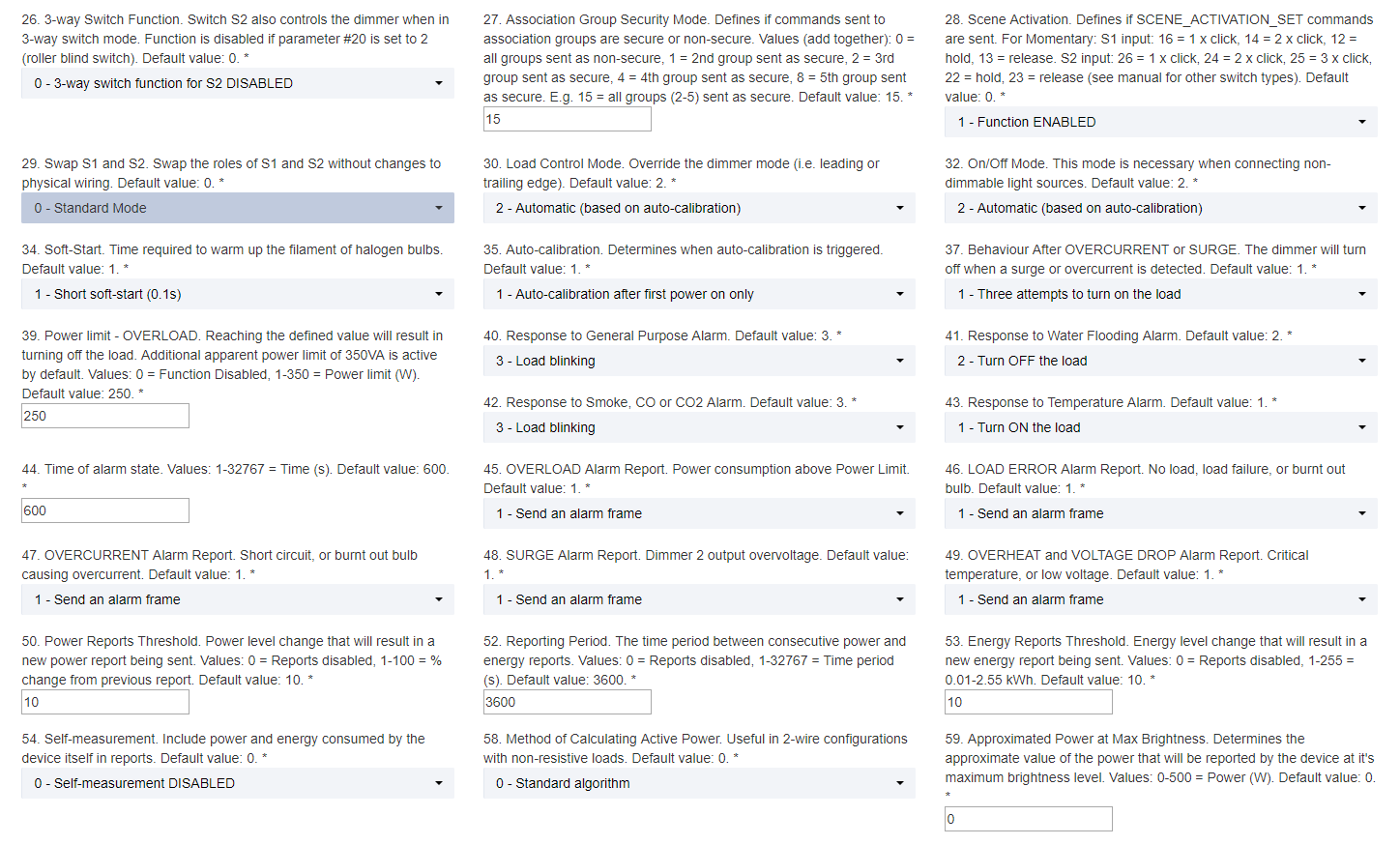Give this a try.
/**
* Copyright 2015 SmartThings
*
* Licensed under the Apache License, Version 2.0 (the "License"); you may not use this file except
* in compliance with the License. You may obtain a copy of the License at:
* http://www.apache.org/licenses/LICENSE-2.0
*
* Unless required by applicable law or agreed to in writing, software distributed under the License is distributed
* on an "AS IS" BASIS, WITHOUT WARRANTIES OR CONDITIONS OF ANY KIND, either express or implied. See the License
* for the specific language governing permissions and limitations under the License.
*
*/
metadata {
definition (name: "Fibaro Dimmer 2 UK", namespace: "smartthings", author: "rajiv") {
capability "Energy Meter"
capability "Actuator"
capability "Switch"
capability "Power Meter"
capability "Polling"
capability "Refresh"
capability "Sensor"
capability "Configuration"
capability "Switch Level"
command "reset"
command "configureAfterSecure"
fingerprint deviceId: "0x1001", inClusters: "0x5E, 0x20, 0x86, 0x72, 0x26, 0x5A, 0x59, 0x85, 0x73, 0x98, 0x7A, 0x56, 0x70, 0x31, 0x32, 0x8E, 0x60, 0x75, 0x71, 0x27, 0x22, 0xEF, 0x2B"
}
// simulator metadata
simulator {
status "on": "command: 2003, payload: FF"
status "off": "command: 2003, payload: 00"
status "09%": "command: 2003, payload: 09"
status "10%": "command: 2003, payload: 0A"
status "33%": "command: 2003, payload: 21"
status "66%": "command: 2003, payload: 42"
status "99%": "command: 2003, payload: 63"
for (int i = 0; i <= 10000; i += 1000) {
status "power ${i} W": new hubitat.zwave.Zwave().meterV3.meterReport(
scaledMeterValue: i, precision: 3, meterType: 4, scale: 2, size: 4).incomingMessage()
}
for (int i = 0; i <= 100; i += 10) {
status "energy ${i} kWh": new hubitat.zwave.Zwave().meterV3.meterReport(
scaledMeterValue: i, precision: 3, meterType: 0, scale: 0, size: 4).incomingMessage()
}
["FF", "00", "09", "0A", "21", "42", "63"].each { val ->
reply "2001$val,delay 100,2602": "command: 2603, payload: $val"
}
}
// tile definitions
tiles(scale: 2) {
multiAttributeTile(name:"switch", type: "lighting", width: 6, height: 4, canChangeIcon: true){
tileAttribute ("device.switch", key: "PRIMARY_CONTROL") {
attributeState "on", label:'${name}', action:"switch.off", icon:"st.switches.switch.on", backgroundColor:"#79b821", nextState:"turningOff"
attributeState "off", label:'${name}', action:"switch.on", icon:"st.switches.switch.off", backgroundColor:"#ffffff", nextState:"turningOn"
attributeState "turningOn", label:'${name}', action:"switch.off", icon:"st.switches.switch.on", backgroundColor:"#79b821", nextState:"turningOff"
attributeState "turningOff", label:'${name}', action:"switch.on", icon:"st.switches.switch.off", backgroundColor:"#ffffff", nextState:"turningOn"
}
tileAttribute ("device.level", key: "SLIDER_CONTROL") {
attributeState "level", action:"switch level.setLevel"
}
}
valueTile("power", "device.power", decoration: "flat", width: 2, height: 2) {
state "default", label:'${currentValue} W'
}
valueTile("energy", "device.energy", decoration: "flat", width: 2, height: 2) {
state "default", label:'${currentValue} kWh'
}
standardTile("reset", "device.energy", inactiveLabel: false, decoration: "flat", width: 2, height: 2) {
state "default", label:'reset kWh', action:"reset"
}
standardTile("configureAfterSecure", "device.configure", inactiveLabel: false, decoration: "flat", width: 2, height: 2) {
state "configure", label:'', action:"configureAfterSecure", icon:"st.secondary.configure"
}
standardTile("refresh", "device.power", inactiveLabel: false, decoration: "flat", width: 2, height: 2) {
state "default", label:'', action:"refresh.refresh", icon:"st.secondary.refresh"
}
main(["switch","power","energy"])
details(["switch","power","energy","configureAfterSecure","refresh","reset"])
}
}
def parse(String description) {
log.trace(description)
def result = null
if (description != "updated") {
def cmd = zwave.parse(description, [0x20: 1, 0x26: 3, 0x32: 3, 0x25: 1, 0x98: 1, 0x70: 1, 0x85: 2, 0x9B: 1, 0x90: 1, 0x73: 1, 0x30: 1, 0x28: 1, 0x72: 1])
if (cmd) {
result = zwaveEvent(cmd)
}
}
log.debug "Parsed '${description}' to ${result.inspect()}"
return result
}
// Devices that support the Security command class can send messages in an encrypted form;
// they arrive wrapped in a SecurityMessageEncapsulation command and must be unencapsulated
def zwaveEvent(hubitat.zwave.commands.securityv1.SecurityMessageEncapsulation cmd) {
log.trace(cmd)
def encapsulatedCommand = cmd.encapsulatedCommand([0x20: 1, 0x26: 3, 0x32: 3, 0x25: 1, 0x98: 1, 0x70: 1, 0x85: 2, 0x9B: 1, 0x90: 1, 0x73: 1, 0x30: 1, 0x28: 1, 0x72: 1]) // can specify command class versions here like in zwave.parse
if (encapsulatedCommand) {
return zwaveEvent(encapsulatedCommand)
} else {
log.warn "Unable to extract encapsulated cmd from $cmd"
createEvent(descriptionText: cmd.toString())
}
}
def zwaveEvent(hubitat.zwave.commands.basicv1.BasicReport cmd) {
log.trace(cmd)
dimmerEvents(cmd)
}
def zwaveEvent(hubitat.zwave.commands.basicv1.BasicSet cmd) {
log.trace(cmd)
dimmerEvents(cmd)
}
def zwaveEvent(hubitat.zwave.commands.switchmultilevelv3.SwitchMultilevelReport cmd) {
log.trace(cmd)
dimmerEvents(cmd)
}
def zwaveEvent(hubitat.zwave.commands.switchbinaryv1.SwitchBinaryReport cmd)
{
log.trace(cmd)
dimmerEvents(cmd)
}
def dimmerEvents(hubitat.zwave.Command cmd) {
log.trace(cmd)
def result = []
def value = (cmd.value ? "on" : "off")
def switchEvent = createEvent(name: "switch", value: value, descriptionText: "$device.displayName was turned $value")
result << switchEvent
if (cmd.value) {
result << createEvent(name: "level", value: cmd.value, unit: "%")
}
if (switchEvent.isStateChange) {
result << response(["delay 3000", zwave.meterV2.meterGet(scale: 2).format()])
}
return result
}
def zwaveEvent(hubitat.zwave.commands.meterv3.MeterReport cmd) {
log.trace(cmd)
if (cmd.meterType == 1) {
if (cmd.scale == 0) {
return createEvent(name: "energy", value: cmd.scaledMeterValue, unit: "kWh")
} else if (cmd.scale == 1) {
return createEvent(name: "energy", value: cmd.scaledMeterValue, unit: "kVAh")
} else if (cmd.scale == 2) {
return createEvent(name: "power", value: Math.round(cmd.scaledMeterValue), unit: "W")
} else {
return createEvent(name: "electric", value: cmd.scaledMeterValue, unit: ["pulses", "V", "A", "R/Z", ""][cmd.scale - 3])
}
}
}
def zwaveEvent(hubitat.zwave.Command cmd) {
log.trace(cmd)
log.debug "No handler for $cmd"
// Handles all Z-Wave commands we aren't interested in
createEvent(descriptionText: cmd.toString(), isStateChange: false)
}
def on() {
log.trace("on")
secureSequence([
zwave.basicV1.basicSet(value: 0xFF),
zwave.switchMultilevelV1.switchMultilevelGet()
])
}
def off() {
log.trace("off")
secureSequence([
zwave.basicV1.basicSet(value: 0x00),
zwave.switchMultilevelV1.switchMultilevelGet()
])
}
def poll() {
log.trace("poll")
secureSequence([
zwave.meterV2.meterGet(scale: 0),
zwave.meterV2.meterGet(scale: 2)
])
}
def refresh() {
log.trace("trace")
secureSequence([
zwave.meterV2.meterGet(scale: 0),
zwave.meterV2.meterGet(scale: 2)
])
}
def reset() {
log.trace("reset")
return secureSequence([
zwave.switchMultilevelV1.switchMultilevelGet(),
zwave.meterV2.meterReset(),
zwave.meterV2.meterGet(scale: 0),
zwave.meterV2.meterGet(scale: 2)
])
}
def setLevel(level) {
log.trace("setlevel")
if(level > 99) level = 99
secureSequence([
zwave.basicV1.basicSet(value: level),
zwave.switchMultilevelV1.switchMultilevelGet()
], 5000)
}
def configureAfterSecure() {
log.debug "configureAfterSecure()"
secureSequence([
zwave.configurationV1.configurationSet(parameterNumber: 20, size: 1, scaledConfigurationValue: 1), // Enable Dimmer to work with Toggle Switch
zwave.configurationV1.configurationSet(parameterNumber: 26, size: 1, scaledConfigurationValue: 1), // S2 can control dimmer as well
zwave.configurationV1.configurationSet(parameterNumber: 32, size: 1, scaledConfigurationValue: 1), // On/Off Mode (0=Dimmer,1=On/Off,2=Auto)
zwave.configurationV1.configurationSet(parameterNumber: 35, size: 1, scaledConfigurationValue: 0), // Auto Calibration (0=No after Power On, 1=On First Power On, 2=On Each Power On)
// Register for Group 1
zwave.associationV2.associationSet(groupingIdentifier:1, nodeId: [zwaveHubNodeId]),
// Register for Group 2
zwave.associationV2.associationSet(groupingIdentifier:2, nodeId: [zwaveHubNodeId]),
])
}
def configure() {
// Wait until after the secure exchange for this
log.debug "configure()"
}
def updated() {
log.debug "updated()"
response(["delay 2000"] + configureAfterSecure() + refresh())
}
private secure(hubitat.zwave.Command cmd) {
log.trace(cmd)
zwave.securityV1.securityMessageEncapsulation().encapsulate(cmd).format()
}
private secureSequence(commands, delay=200) {
log.debug "$commands"
delayBetween(commands.collect{ secure(it) }, delay)
}








